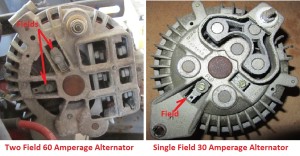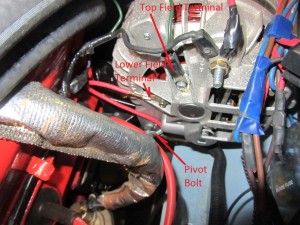Early Plymouth Alternator Replacement reflects a problem that may be facing many having difficulty finding an EXACT rebuilt alternator to replace their aged and functionally disabled original component.
Vector files for the following discussion are:
EarlyPlymouthDodgeAlternatorReplacement (.doc)
EarlyPlymouthDodgeAlternatorReplacement (.pdf)
Content of the above files is as follows:
Part 1
This Early Plymouth Alternator Replacement covers alternator replacement in pre-70 models with an original 35 amp alternator including other Chrysler Products. You may be faced with putting in a 60 amp alternator that many part stores seem to offer instead of the 35 amp model. The stores even list them as 35 amp (new or rebuilt) but actually they are 60 amp and look slightly different. Here is an example of a store offering a 35 amp alternator that was actually a 60 amp alternator when I checked it out at the store…the picture shows a 60 amp too:
https://www.napaonline.com/napa/en/p/RSE2131001/RSE2131001_0211373632
A noticeable difference between the original 35 amp alternator and the store offered 60 amp is the number of field terminals. Original 35 amp alternators tend to have a single field terminal while the offered 60 amp alternator may have two field terminals.
The difference can be readily spotted from this view and compared:
The single field terminal is located pointing at the alternator pivot bolt while the double field terminals are up and to the left of the alternator pivot bolt. When you are viewing the proposed alternator for your application this is an identifier as to whether you are getting a 35 amp alternator or a 60 or greater amp alternator.
Physically the two are nearly exact for bolting into place and accepting the wire connections.
There is one added wiring step that you may need to take to make the alternator work in your single field pre-70 Plymouth or Dodge; a ground wire added that grounds one of the 60 amp alternator field terminals to a convenient ground point such as the alternator pivot bolt:
In the above case the red wire grounds the lower field terminal to the alternator pivot bolt.
There is online info available on using several different later model alternators such as in:
http://www.slantsix.org/forum/viewtopic.php?t=28160
The difference in output (35 amp versus 60 amp) can become a problem if the battery is deeply discharged and the full alternator output is called upon otherwise there is no major issue in making the change.
Unfortunately, a simple act like leaving the headlights on for an extended period of time while the engine isn’t running can deeply discharge the battery and upon startup the higher output from the 60 amp alternator could overload the aged pre-70 factory original wiring and somewhat corroded and/or oxidized original connections.
Changing the voltage regulator to a heavy duty unit is a safe approach using a regulator like Bluestreak VR-106.
See this discussion for all the possibilities for the Voltage Regulator:
http://www.slantsix.org/forum/viewtopic.php?p=81280&highlight=35+alternator+60#81280
The wiring and bulkhead connection is another area for discussion.
Part 2 will cover one way to deal with avoiding overloading that factory original wiring circuit. If you want a peak at some background on this subject see:
http://slantsix.org/forum/viewtopic.php?p=311268#311268
http://slantsix.org/forum/viewtopic.php?p=355869#355869
In summary you have two steps to use a 60 amp two field alternator in place of your 35 amp:
- Adding ground wire to the 2nd field terminal & installing heavy duty Voltage Regulator
- Reduce the chances of overloading your pre-70 wiring circuits (see part 2)



I have questions re. my 41 Plymouth P12 PS. I would like to speak to someone about selling the original engine with 42,000 miles. It runs good. Am putting in Chevy engine. Planning on extended tour cross country. Please notify of what process I need to do to sell the engine and transmission. Will watch for an email.
People in the Plymouth Owners Club buy and sell parts using the Plymouth Bulletin and the Plymouth Owners Club Region websites.
PLYMOUTH BULLETIN
The Plymouth Owners Club Bulletin comes out bimonthly and is MAILED to a bigger audience with interest in Plymouths then the websites. Surprisingly….The audience is located in the entire planet.
I think their current policy is the ad must be mailed to:
Editor, Plymouth Bulletin
288 Strathmillan Rd.
Winnipeg, MB, R3J 2V5, Canada
or emailed to: editor@plymouthbulletin.com
I also think their policy requires a $10 fee per ad if you are not a member of the Plymouth Owners Club
PLYMOUTH REGION WEBSITE
Obviously selling it locally (when it comes to big/heavy items) is the best scenario & most likely to find a willing & needy buyer. Consequently advertising in the website of the Region website that covers your state is your best bet.
I can give you the email for the Region website covering your state if you provide the state.
Stating the condition of the engine is obvious along with the engine ID number. If the engine has been run recently that is telling. If it hasn’t been running recently the sell becomes more difficult. So stating the condition & ID would be bare minimums……..just because an engine came out of a 41 doesn’t mean it’s a 41 engine.
So provide the engine condition, ID, and state located & I’ll either supply you a website email or place the “For Sale” ad in our Region Website (at no charge) if your engine is located in New England Area.
Don P.
(editor for Colonial Region Plymouth Website)